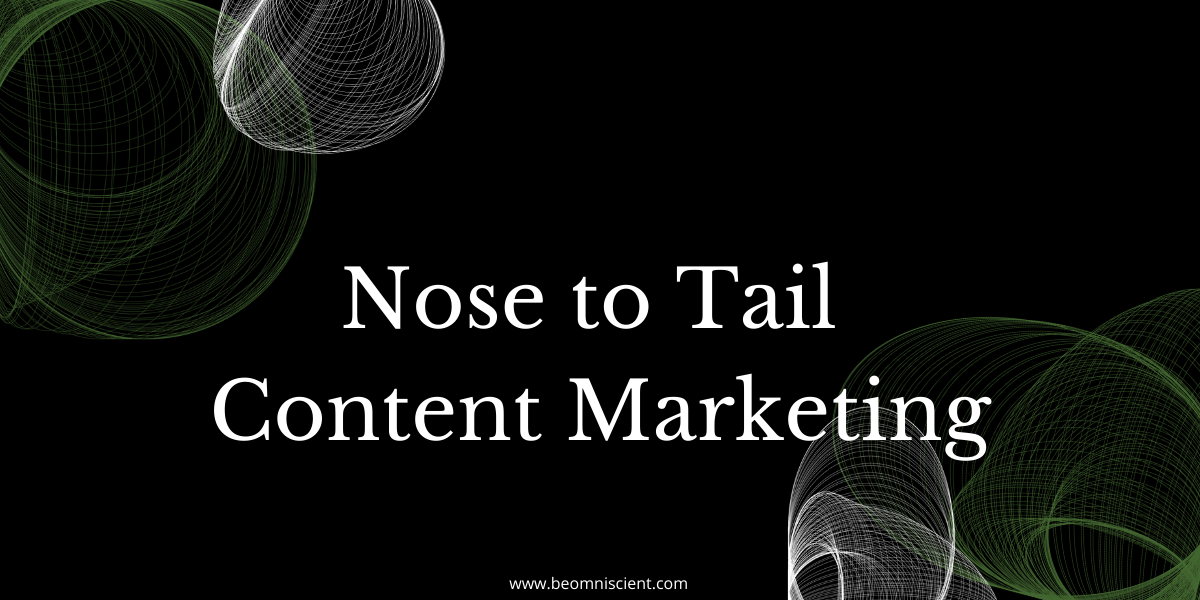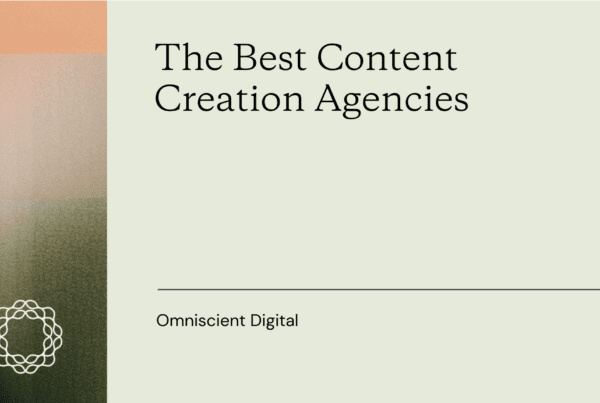
Nose-to-tail eating is the philosophy of making use of every part of the animal in food preparation.
You waste nothing, not even the pigs feet, livers, or tripe (especially not the tripe, as it makes for a wonderful soup).
What in the world could this have to do with content marketing?
Well, most content marketers are wasteful creatures.
We dump months into persona planning, another leg of time into keyword research, and then another week or two putting our plan together into an editorial calendar.
Then we pour our blood, sweat, and tears into a blog post, and then… we publish it. That’s it. All that effort for one simple blog post.
As a matter of both taste and efficiency, I find this both uncouth and irresponsible. If you’re a scrappy startup, you’ve gotta seek leverage and maximize your efficiency. If you’re an established enterprise, you can get away with some waste — but given the option, why would you?
Let me make my point through some decision theory, and then I’ll show you what I mean when I say “nose to tail” content (i.e. how I get the most out of every idea I come up with).
Expected Value, Optionality, and Leverage
To build some background theory for this approach to content marketing, “Nose to Tail Content,” let’s explore three concepts:
- Expected Value
- Optionality
- Leverage
Expected Value
I talk about expected value a lot, mainly because it’s a generically useful framework for decision making. It’s “an anticipated value for an investment at some point in the future.”
If you can calculate the distribution of costs and the average cost of an investment, as well as the distribution of possible outcomes and their probabilities, then you can calculate the expected value of an action.
This is useful, for example, in planning A/B tests.
If the cost of an experiment were three months of planning and development plus the cost of salaries of those involved (not to mention the opportunity cost involved), then the expected average return of the experiment would have to be higher than the expected costs. That’s why it pays to both lower the time and resources it takes to run an experiment, and also to run experiments that have higher potential for impact (in other words, the I and E in the ICE framework).
This is the whole reason for generating prioritization frameworks: to maximize expected value.
We can think about the same deal with content marketing (related reading: content economics).
If you know that it will take you a given amount of time and/or money to create a blog post, then the expected average return has to be greater than that cost.
Now, in content economics, you typically have the benefit of long term returns if you rank in search, so the math is in your favor if you’re playing the long game. If you write an article that costs $1000, and then article brings in an expected $50 per month, then it would “break even” after 20 months. All upside after that.
This, by the way, is called a “break-even point,” and it’s one of the main utilities of building a content growth model.
To adjust your break-even point and ROI, you can either lower the cost of content production or increase the potential upside. It’s easier to think of ways to lower the costs of production (i.e. paying less for writers, doing lazy roundup posts, automating components of your workflow, or increasing the domain rating of your website over time).
But increasing the upside is also an impactful and feasible lever.
You can either do that through your strategy and planning (i.e. going after bigger keyword and topic opportunities), or by increasing the potential reach of your content from a distribution standpoint.
In other words, what if one article (costing $1000), could also be turned into a SlideShare presentation, 14 Tweets, 4 LinkedIn posts, a podcast, 4 YouTube clips, and a conference talk, for a marginal cost of $500. Your total cost increases to $1500, but your expected upside becomes much, much higher.
Optionality
Expected outcomes are always probabilistic.
Even if you’re building a content roadmap fully based on keyword research and search volume, there are fluctuating variables that lead to different outcomes.
For example, let’s say a keyword (“best practice pad for drummers”) gets 1,000 monthly searches.
The SEO tool you use could be inaccurate in either direction.
The percentage of clicks on that SERP could vary widely. The click through rate for different positional rankings on the SERP varies. Where you land on the SERP and for how long you rank there are questionable.
With social and other distribution platforms, it’s even harder to predict the exact outcome.
In fact, these channels tend to favor a power law, where most content does nothing at all, and some content goes quite viral. Therefore, your best bet is to minimize the cost of the “at bat” or getting exposure on these channels, and then maximize your exposure and potential for high upside.
You could argue with me here and say that, “no, the ideal strategy is to carefully craft your articles to go viral and be more shareable.” If you can craft and predict which articles will go viral, come work for Omniscient and we’ll pay you handsomely. Otherwise, let’s just call it for what it is: virality is a serendipitous occurrence caused by frequency of publication and also quality/planning, but it is certainly not highly predictable.
This approach, in a nutshell, is a barbell strategy. SEO-driven content is quite predictable (within a range). Other distribution channels have volatile and sometimes very high (but most of the time very low) outcomes.
Repurposing a single idea to many places gives you a low cost “option” via exposure to call high rewards and collect serendipitous success from time to time. It’s a slot machine that costs a penny and gives very infrequent rewards (but very high rewards when it does).
Leverage
The goal is to get the most out of your effort. When you have a great content idea, why get paid just once for it?
Media is our form of leverage. It helps us to decouple the time inputs of our work from the potential outputs:
The more exposure you give your content, the more you put yourself in the position to gain additional upside and results. If repurposing your content to other platforms is feasible and cheap, doing so gives you access to those audiences.
How the Sausage is Made: an Inside Look at “Nose to Tail” Content
Since Omniscient is a small agency with very little time to spend creating our own content (cobbler’s kids have no shoes), we have to get creative and leverage the shit out of any effort we put into content creation.
Here’s an example from a recent piece we worked on.
Before any content creation occurred, we started working on a plan of attack. We split our content creation roadmap into four categories:
- How to (SEO driven content)
- Thought leadership (like the piece you’re reading right now)
- Podcasts
- Case studies
For the first category, we did keyword research and built a content roadmap report, just like we teach you to do in our content strategy course.
We came up with the keyword “content calendar,” so planned a piece on “how to create a content calendar.”
Karissa, our growth and content marketer, wanted to fill the piece with insights and quotes from the agency founders (me, David, and Allie) and try to pull actual tactical steps and lessons that we’ve learned from working with many clients.
Instead of just sending us a few questions via Slack, though, we decided to jump on a Zoom call and record it. We chatted, behind-the-scenes, about building a content calendar. This becomes a podcast.
Since it was also recorded with video, we’re uploading clip segments to YouTube.
Three pieces of content: YouTube and podcast, and the blog post itself.
The blog post, of course, presented the opportunity to use our own content calendar template, so we created that as a lead magnet/content upgrade. That’s four pieces of content from the same idea now.
The blog post contains tons of clips and quotes that we’re effectively splitting across a few dozen Tweets and LinkedIn posts and email newsletters. We’ll just call that three more pieces of content, so that brings us to seven.
Finally, we’re planning a webinar to complete our strategy series (content growth modeling, building a content roadmap report, and then building a content calendar). This will be both live and then, afterwards, given as an on-demand webinar/lead magnet. We’ll also use the slides from the webinar to upload to SlideShare and HubSpot Slides.
We can almost certainly repurpose pieces of the webinar itself for more content, but even without including that step, we’re at 10 individual pieces of content from one initial seed of an idea.
Lots of bang for our buck!
Mindset Uber Alles (But Tools Help, Too)
Nose to Tail Content Marketing is an operating system. It’s a mindset shift. Instead of looking at action items as being linearly connected to a singular output, you ask, “how can I get the *most* out of this single topic/idea?”
That said, there are a few tools that will help you distribution and repurpose your content more easily. Here are a few tools I use to do so.
1. Canva
Images can rank in search, and they also make content more shareable. If you’re in a consumer space, they can also be incredibly useful for traffic generation through Pinterest and Instagram.
Canva is the easiest way to create images.
2. Buffer
I hate doom-scrolling on Twitter, so I try to schedule my Tweets when possible. Buffer is the simplest tool to do so, in my opinion.
3. Zoom
When we work on an article, we do a Zoom interview or brainstorm session and record it. You can also use Descript for transcripts and audiograms.
We also use Zoom for our webinars.
4. Loom
Loom is amazing for screenshares and walkthroughs. I use it to record and publish tutorials in my more technical articles.
5. HubSpot Slides
If you have a B2B audience, Slides can be a great way to illustrate your concept, especially if you have a good visual component to what you’re teaching. SlideShare was cool, but isn’t really a thing anymore. HubSpot Slides is a rising network to gain distribution there.
Conclusion
The Nose to Tail Content Marketing Strategy ensures that you’re wasting no effort. This is a big deal if you’re a startup, or really if you’re in any company that cares about resource allocation and ROI.
Get more from your efforts. Repurpose. Don’t waste an idea. Optimize for serendipitous upside.



